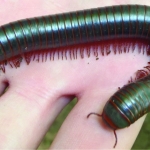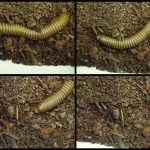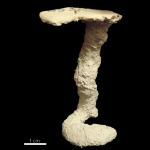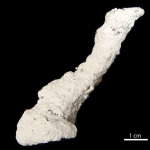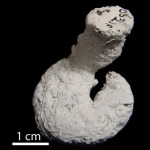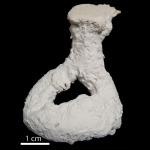North American Millipede(Narceus americanus)
For full details see Bowen and Hembree (2014) in Palaeontologia Electronica.
Description of Organism
- A large North American millipede present in the eastern half of the USA and southeastern Canada at all elevations
- Millipedes have bodies comprised of multiple fused segments (diplosegments), each with two pairs of legs and tracheae
- A calcite-impregnated, chitinous exoskeleton provides physical defense and protection against desiccation
- Adults reach lengths of 10 cm
- Inhabits leaf litter, rotting logs, and soils of temperate to subropical forests
- High tolerance to dry conditions
- Primarily nocturnal in the spring and diurnal year round
- Burrows in winter to avoid cold temperatures and desiccating conditions
Published Descriptions of Organism
Bowen and Hembree (2014)
- Narceus americanus is a large, North American millipede that can reach lengths of up to 10 cm as an adult. The species occurs in the eastern half of the United States and portions of southeastern Canada at all elevations, primarily on temperate to subtropical forest floors. Narceus americanus has a relatively high tolerance for dry conditions which likely accounts for its widespread distribution. Narceus americanus is primarily active at night in the spring and during the daylight hours in winter N. americanus burrows into the soil to avoid desiccating conditions and cold temperatures.
Burrowing Technique
In non-sandy sediments, N. americanus burrows using a compaction technique, ramming its head into the sediment to a length of 3-4 body segments and then pushing the sediment upward, pressing it into the ceiling of the burrow. In sandy sediment the burrow is initiated through excavation; the millipede uses its mandibles to pick up sediment grains and then passes them along each body segment using its legs and moves the grains to the surface. Once the millipede is 3-4 cm below the surface, it switches to a compaction technique. Compressive linings are present around the burrows and are most apparent in clay-rich sediment.
Burrowing Technique Videos
Burrowing Behavior
Narceus americanus begin burrowing within 15 minutes of being placed in the terraria. Burrowing completely below the surface takes from 5-60 minutes. Burrows are used as temporary shelters to permanent dwellings. Some burrows are either not completed or abandoned before being occupied for any significant period of time. Burrows occupied for longer intervals are up to 26 cm deep. Molting occurs in chambers 10 cm below the surface. After a burrow is completed, N. americanus spends most of its time below the surface, returning to the surface only to feed. Most of this activity occurs during dark hours.
Trace Morphology
Narceus americanus produced four distinct burrow architectures: vertical shafts, subvertical ramps, helical burrows, and O-shaped burrows; examples of each are shown below. Modifying features on these architectures include branches, chambers, partial spirals, and additional entrances. Each photo is linked to an information page about the specific burrow architecture shown.
